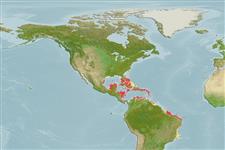分類 / Names
共通名の | 類義語 | Catalog of Fishes(部類, 種) | ITIS | CoL | WoRMS | Cloffa
>
Ophidiiformes (Cusk eels) >
Bythitidae (Livebearing brotulas)
Etymology: Stygnobrotula: Greek, stygnos, -ou = sad, hostile + Latin, brotula = little bud, shoot (Ref. 45335).
Environment: milieu / climate zone / depth range / distribution range
生態学
海 関連する礁. Tropical; - 21°S
Western Atlantic: Bahamas to Brazil (Ref. 40101).
サイズ / 重さ / 年齢
Maturity: Lm ? range ? - ? cm
Max length : 7.5 cm TL オス/雌雄の選別がない; (Ref. 7251)
A common species inhabiting shallow rocky ledges and reefs (Ref. 7251), found deep within the reef during the day (Ref. 9710). A live-bearing species (Ref. 5521).
Life cycle and mating behavior
成熟 | 繁殖 | 放精 | 卵 | 生産力 | 幼生
Nielsen, J.G., D.M. Cohen, D.F. Markle and C.R. Robins, 1999. Ophidiiform fishes of the world (Order Ophidiiformes). An annotated and illustrated catalogue of pearlfishes, cusk-eels, brotulas and other ophidiiform fishes known to date. FAO Fish. Synop. 125(18):178p. Rome: FAO. (Ref. 34024)
IUCNのレッドリストの状況は (Ref. 130435: Version 2024-1)
Human uses
水産業: 興味がない
用具
特記事項
XMLをダウンロードして下さい
インターネットの情報源
Estimates based on models
Preferred temperature (Ref.
123201): 25.9 - 28.2, mean 27.2 °C (based on 482 cells).
Phylogenetic diversity index (Ref.
82804): PD
50 = 1.0000 [Uniqueness, from 0.5 = low to 2.0 = high].
Bayesian length-weight: a=0.01122 (0.00514 - 0.02450), b=3.04 (2.87 - 3.21), in cm total length, based on all LWR estimates for this body shape (Ref.
93245).
栄養段階 (Ref.
69278): 3.3 ±0.5 se; based on size and trophs of closest relatives
回復力 (Ref.
120179): 低い, 4.5年~14年の倍増期間の最小個体群 (Assuming Fec < 100).
Fishing Vulnerability (Ref.
59153): Low vulnerability (10 of 100).
Nutrients (Ref.
124155): Calcium = 139 [79, 281] mg/100g; Iron = 1.07 [0.62, 1.83] mg/100g; Protein = 17.1 [14.6, 19.7] %; Omega3 = 0.234 [0.124, 0.429] g/100g; Selenium = 41.1 [21.3, 81.8] μg/100g; VitaminA = 108 [35, 329] μg/100g; Zinc = 2.32 [1.57, 3.31] mg/100g (wet weight);
